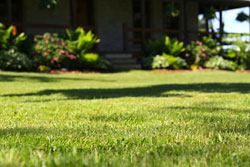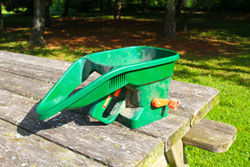 Walking barefoot through a deep green, soft lawn is one of my earliest childhood memories, and so is the experience of the first major mistake of my life. Both go back to when I was three years old, while living at my grandparents’ house in Etobicoke. My grandmother was spreading fertilizer on the grass, and like most three year olds, I wanted to help. That’s why I grabbed a handful of the little grey granules and threw most of them down in one spot. Grandma wasn’t too happy and I soon learned why. Despite her attempts to clean up the mess, it wasn’t long before a patch of grass the size of my playpen turned brown and stayed that way for the rest of the summer. The same fertilizer that made my boyhood lawn so nice also killed part of it, and that’s why basic knowledge is key. Fertilizing your lawn and garden responsibly is one of those things that’s not as simple as it looks. Not that the job is difficult or complicated, just that it takes some basic information that many people don’t have.
Walking barefoot through a deep green, soft lawn is one of my earliest childhood memories, and so is the experience of the first major mistake of my life. Both go back to when I was three years old, while living at my grandparents’ house in Etobicoke. My grandmother was spreading fertilizer on the grass, and like most three year olds, I wanted to help. That’s why I grabbed a handful of the little grey granules and threw most of them down in one spot. Grandma wasn’t too happy and I soon learned why. Despite her attempts to clean up the mess, it wasn’t long before a patch of grass the size of my playpen turned brown and stayed that way for the rest of the summer. The same fertilizer that made my boyhood lawn so nice also killed part of it, and that’s why basic knowledge is key. Fertilizing your lawn and garden responsibly is one of those things that’s not as simple as it looks. Not that the job is difficult or complicated, just that it takes some basic information that many people don’t have.
The first thing to understand is that soil fertility is about three main chemical elements, not just something called “fertilizer”. Nitrogen, phosphorous and potassium are the main substances that plants need to thrive, and these relate to the three numbers you’ll find listed on every legitimate fertilizer product for sale today. Abbreviated N-P-K, fertilizer analysis numbers are percentages, and the product you choose depends on something that doesn’t happen nearly often enough. When it comes to lawn and garden fertility, begin by remembering the 4Rs:
- Right source
- Right rate
- Right time
- Right place
The soil that’s under your lawn and garden may have more than enough nitrogen, phosphorous and potassium, it may have just enough, or it may hardly have any. You can’t tell by looking at it, and this is why a soil analysis is a smart beginning. Without the guidance of a test, you’ll just be guessing, probably putting on too much of one element and not enough of another. I’ve used several soil testing options over the last 30 years, and the simplest I’ve found so far for lawn and garden use is offered by a firm called A Growing Necessity (877.764.5878). Total cost of each kit is $25.70, with a detailed report sent out by mail or email.
 Applying the right amount of the right kind of fertilizer evenly over your lawn comes next, and it’s where a mechanical spreader is key. As I know first-hand from that image of a brown patch of lawn forever burned into my boyhood memory, even application is key. Forget spreading by hand because you won’t get it right.
Applying the right amount of the right kind of fertilizer evenly over your lawn comes next, and it’s where a mechanical spreader is key. As I know first-hand from that image of a brown patch of lawn forever burned into my boyhood memory, even application is key. Forget spreading by hand because you won’t get it right.
If you don’t have the budget to spring for a rolling fertilizer spreader (or the room to store it between seasons), consider an inexpensive hand-crank spreader. I’ve used one here at my place for five years and it works surprisingly well for small to average-size lawns. The only drawback is the need to fill up the small hopper fairly often. I also use mine to spread grass seed in March, on top of the last of the winter snows. Sounds strange, but this seeding time gives the best germination in my experience.
Your soil test will tell you how much fertilizer to apply for a given area of lawn, and fertilizer bags are often helpful for calibrating your spreader. If in doubt, spread less than you need in the first go, then repeat additional passes until you get the right amount applied.
Spreading fertilizer at the right time is key. Spring and fall are your target seasons, but not just for the reasons you might think. Spring application is traditional, especially in terms of nitrogen. This is the element that gives lush, green growth and a fast start to summer beauty. What few people realize is the value of making sure that the soil is also well supplied with potassium near the end of summer and into fall. Growing conditions are usually excellent in autumn, with lots of moisture and decent temperatures.
Fertilizing before a slow, steady rain is a good idea, but not essential. Avoid application before a hard rain, as this can wash nutrients away before they have a chance to sink into the soil for uptake by plants.
It’s inevitable that some fertilizer will inadvertently land on paths and driveways as it’s broadcast. No problem. Just sweep it back onto the grass or garden. Also, don’t apply conventional fertilizers near lakes, streams, rivers or ponds because you don’t want to encourage algae growth. Established lawns near bodies of water should be fertilized only with low phosphorous or phosphorous-free fertilizers, as shown by the middle number in the three-number fertilizer analysis.
An unfortunate example of government extending legislation beyond legitimate boundaries has led to the elimination of phosphorus in lawn fertilizers for sale through conventional, retail outlets. The fear is that ordinary people are too unsophisticated to use phosphorus properly, even though phosphorus can quite easily be applied responsibly by anyone on soil not near water courses. If your soil test shows low phosphorus, you’ll still find fertilizer products containing it at agricultural supply outlets.
Managing the fertility of your lawn and garden isn’t complicated. It just requires a little knowledge, some lead time for your soil analysis report to come in, and the diligence to follow what you read. After that, make sure you spend at least a little time walking barefoot through the lush, green results.